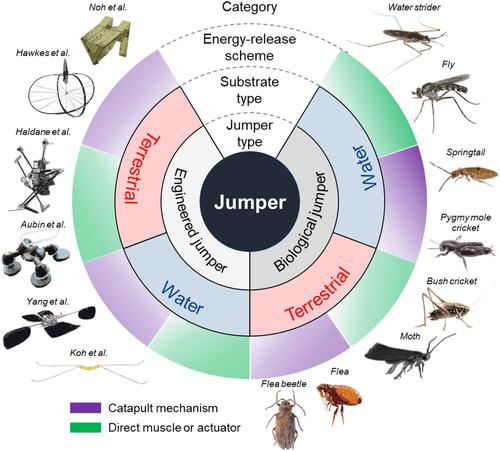当前位置:
X-MOL 学术
›
Ann. N. Y. Acad. Sci.
›
论文详情
Our official English website, www.x-mol.net, welcomes your feedback! (Note: you will need to create a separate account there.)
Comparison of water and terrestrial jumping in natural and robotic insects
Annals of the New York Academy of Sciences ( IF 4.1 ) Pub Date : 2024-06-19 , DOI: 10.1111/nyas.15172 Je‐Sung Koh 1 , Sang‐Min Baek 2, 3 , Baekgyeom Kim 1 , Kyu‐Jin Cho 2, 3 , Ho‐Young Kim 3
Annals of the New York Academy of Sciences ( IF 4.1 ) Pub Date : 2024-06-19 , DOI: 10.1111/nyas.15172 Je‐Sung Koh 1 , Sang‐Min Baek 2, 3 , Baekgyeom Kim 1 , Kyu‐Jin Cho 2, 3 , Ho‐Young Kim 3
Affiliation

|
Jumping requires high actuation power for achieving high speed in a short time. Especially, organisms and robots at the insect scale jump in order to overcome size limits on the speed of locomotion. As small jumpers suffer from intrinsically small power output, efficient jumpers have devised various ingenuous schemes to amplify their power release. Furthermore, semi-aquatic jumpers have adopted specialized techniques to fully exploit the reaction from water. We review jumping mechanisms of natural and robotic insects that jump on the ground and the surface of water, and compare the performance depending on their scale. We find a general trend that jumping creatures maximize jumping speed by unique mechanisms that manage acceleration, force, and takeoff duration under the constraints mainly associated with their size, shape, and substrate.
中文翻译:

自然昆虫和机器昆虫水中和陆地跳跃的比较
跳跃需要高驱动力才能在短时间内达到高速。特别是昆虫级的生物体和机器人会跳跃,以克服运动速度的尺寸限制。由于小型跳线本质上功率输出较小,因此高效跳线设计了各种巧妙的方案来放大其功率释放。此外,半水生跳水运动员采用了专门的技术来充分利用水的反应。我们回顾了在地面和水面跳跃的自然昆虫和机器昆虫的跳跃机制,并根据它们的规模比较了性能。我们发现一个普遍趋势,即跳跃生物通过独特的机制来最大限度地提高跳跃速度,这些机制在主要与其大小、形状和基质相关的约束下管理加速度、力和起飞持续时间。
更新日期:2024-06-19
中文翻译:

自然昆虫和机器昆虫水中和陆地跳跃的比较
跳跃需要高驱动力才能在短时间内达到高速。特别是昆虫级的生物体和机器人会跳跃,以克服运动速度的尺寸限制。由于小型跳线本质上功率输出较小,因此高效跳线设计了各种巧妙的方案来放大其功率释放。此外,半水生跳水运动员采用了专门的技术来充分利用水的反应。我们回顾了在地面和水面跳跃的自然昆虫和机器昆虫的跳跃机制,并根据它们的规模比较了性能。我们发现一个普遍趋势,即跳跃生物通过独特的机制来最大限度地提高跳跃速度,这些机制在主要与其大小、形状和基质相关的约束下管理加速度、力和起飞持续时间。











































 京公网安备 11010802027423号
京公网安备 11010802027423号